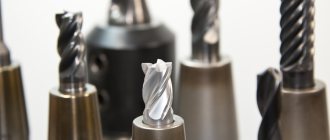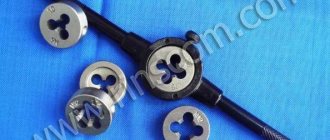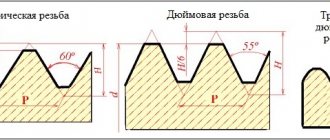Purpose of files
A file is a universal-purpose hand tool capable of cutting off a thin layer from the surface of the material being processed with one forward movement. It can be used to solve many different problems:
- Clean parts and workpieces from rust and other types of corrosion.
- Remove a layer of dirt or paint.
- Turn the part until the required size is obtained.
- Sharpen other tools used in everyday work.
- Clean electrical contacts in electrical equipment systems.
- Grind and polish the surface of metal and other materials.
Types of files
Modern schoolchildren, finding themselves in tool shops on excursions, often look with a grin at the tools used by toolmakers. There may be sophisticated machines nearby that can cut off thick layers of metal within a few seconds.
And mechanics process the part using hand tools with handles, moving them over the workpieces, achieving the desired size or type of part. Often, to clarify some features, the results of work are viewed through magnifying glasses.
However, sometimes the fine finishing of a product cannot be entrusted to a machine. Only with the help of a file or its younger brother, the needle file, can the required parameters be achieved. These tools are used to remove a layer of metal.
Most often, a strong steel strip has a notch on it. These are low teeth located in a certain sequence (a special notch is applied). A special standard (GOST 1465-80) approves the rules for the location of teeth and their shape.
For manufacturing, carbon steels (U9...U11) or special iron alloys with alloying elements are used. The files undergo heat treatment, as a result of which the surface hardness reaches up to 54...60 HRC (Rockwell hardness).
For ease of use, the end has a triangular or cylindrical shank. A handle is placed on the shank. It is made from different materials (wood, plexiglass, metal). Professionals prefer to use wooden handles made of birch or walnut.
Important! To prevent the handle from splitting when the shank is driven in, a metal ring is installed at the end.
Rasp and its difference from a file
Despite its rough appearance, the rasp is intended exclusively for working on soft metals, as well as wood, plastic, rubber and leather. A rasp differs from a file not only in its larger size, but also in the type of notch - point. It is through the use of a pinpoint cut with high roughness that it is possible to achieve high efficiency in processing materials.
These tools come in different shapes (flat, round and semicircular) and sizes, and they are often used not for grinding, but for roughing materials. For their manufacture, steel grades U8, U10 and U7 are used. Despite the great similarity with a file, a rasp differs from it not only in external features, but also in purpose.
Tool steels for making files
While studying the properties of steel, we noticed that at a certain carbon content it becomes possible to obtain high hardness using special heat treatment. The low carbon content does not allow hardening, which increases the strength properties of the metal.
Only at a concentration of 0.8% and above do the properties of the Fe-FeC₃ alloy change (the properties are studied in a special course in metal technology, called “Materials Science”). Annealed steel is quite ductile and can be processed on metal-cutting machines. There is a condition in which high plasticity is noted. It is called austenite. Achieved at a temperature of 727 ⁰C and above.
Only hypereutectoid steels can be quenched and tempered. If there are no other additives, then they are usually designated as U8...U13. The letter “U” characterizes carbon steel, and the number indicates the carbon content in hundredths of a percent.
Attention! To carry out hardening, it is necessary to heat the steel part to the austenite temperature and above. It can be easily identified using a magnet. When the desired value is reached, the magnetic properties completely disappear when heated.
Some people believe that heating to the appropriate temperature is enough. When heated, the thermal conductivity of the metal decreases sharply. Within one minute, parts weighing about 1 kg are heated to a depth of 0.10...0.13 mm.
Important! To harden the surface to a depth of 1.5...2.5 mm, you will need to hold it at the desired temperature for at least 15...20 minutes. Less deep hardening may result in the measuring cone on the Rockwell instrument falling through a thin layer of hardened metal. The result will be disappointing.
Hardening is carried out in water, air and mineral oil. A high cooling rate promotes deeper hardening of the metal. When making cutting tools, they are hardened in oil. Steel cooling occurs at a rate of 400…450 ⁰/sec.
After hardening, the parts acquire a certain fragility. Therefore, to relieve internal stresses, low tempering is performed. It occurs at a temperature of 180...250 ⁰С. The part is placed in muffle furnaces heated to a given temperature. Keep in them for at least 30...40 minutes. Then they allow it to cool slowly.
In practice, heat treatment of file metal occurs in the following sequence:
- The workpiece is heated to a temperature of 900…920 ⁰С (the higher value is explained by the fact that less time is required for internal heating of the metal).
- Maintain in a heated state for 15...20 minutes.
- It is hardened in mineral oil (it is allowed to use waste from internal combustion engines).
- Hardness testing is carried out, and with proper heating and cooling, hardened trostite (HRC 54...58) is obtained.
- The workpiece is placed in a muffle furnace at a temperature of 200…210 ⁰С.
- Leave for 30...40 minutes and take out.
- It cools down in air (temperature 18...22 ⁰С) on its own.
- The hardness is checked; for tempered trostite (the state of hardened and tempered metal), the hardness increases by 2...4 units.
To increase the strength and hardness of steels, alloying elements are added during welding. They make it possible to improve performance characteristics and obtain metal with desired properties.
File shapes
Types of files for metal have been developed over the past two hundred and fifty years. Dimensions and parameters were determined depending on the tasks that needed to be performed. Therefore, the shape of the teeth was also adjusted.
Initially, craftsmen were required to process cast iron, as well as products made of brass and bronze. The castings had a gating system and a burr. They were sawed off, and then the surface was polished. Files with different tooth sizes were used. For rough processing, a tool was used that was capable of removing up to 0.5...1.0 mm of a layer in one movement.
In the future, modern craftsmen have sets of hand-held cutting tools, which they use to bring parts to the required parameters. At manufacturing enterprises there is a category of workers (mechanics). One of the main tools is files.
Popular models of wood files for 2022
There are not many companies producing wood files in this category. The list of the best companies includes:
- Banco;
- "Top Tools".
Model “1-477-08-2-2” from (Sweden)
Purpose: for removing burrs, filing sharp corners, flat surfaces and shoulders, as well as holes, large curves and concave surfaces.
Powerful files with a comfortable handle in orange and black. Each file in the set is blunt-nosed, which increases the user’s safety during operation. The set contains tools of various shapes, one of which is a semicircular rasp. The holders have holes for hanging and convenient storage of files.
Wood file handle “1-477-08-2-2” from (Sweden)
Specifications:
| Section: | circle, triangle, rectangle, semicircle |
| Length: | 20 cm |
| Notch class: | №2 |
| Kit: | 5 pieces. |
| Weight: | 960 grams |
| Package size (centimeters): | 35/18/4 |
| Material: | steel |
| Manufacturer country: | Portugal |
| Average price: | 4000 rubles |
Banco 1-477-08-2-2
Advantages:
- Design;
- High productivity of wood removal;
- Durability;
- Comfortable handle;
- Variety of elements in the set;
- Quality.
Flaws:
- Expensive set.
Model "05A530" from (Poland)
Purpose: for working on wood.
Wood construction tool with plastic handle and hole for easy storage. They are made of carbon steel and are excellent at processing and sanding wooden surfaces. Handle color is red.
Files “05A530” from (Poland)
Specifications:
| Type: | flat, semicircular, round |
| Length: | 28 cm. |
| Net weight: | 193 grams |
| Number per pack: | 3 pcs. |
| Parameters for one file (centimeters): | 9,5/1,5/35 |
| Weight of one file: | 18 gr. |
| Manufacturer country: | China |
| Average cost: | 158 rubles |
Top Tools 05A530
Advantages:
- Light weight;
- Anti-slip handle;
- Durable;
- Affordable price.
Flaws:
- Not identified.
Classification by section shape
The form determined the name and purpose of the files, and the main classification was created on it. Depending on the profile of the surface being processed, the cross-section of the tool is selected. Manufacturers of files suggest using special hand tools with the following sections:
- Flat – files of this shape are suitable for processing flat and rounded (protruding) surfaces. This is the most common cross-section for such a tool.
- Square files are used for processing rectangular and square holes. They grind rectangular grooves on the surface.
- Round - they are used to process internal cavities and holes, remove sagging from welds and flash from castings. The desired configuration is achieved by finishing elliptical surfaces inside the part.
- Triangular - in cross-section they represent a regular triangle with an angle of inclination of the surfaces of 60 ⁰ to each other. Most often, such a tool is used to sharpen the teeth of another tool, for example, a hacksaw for sawing wood.
- Special - at some enterprises, specially shaped files are made in tool shops. For example, in the manufacture of air-cooled two-stroke internal combustion engines, the inlet ports must be modified. The blanks are produced by casting, but finishing is done manually (cheaper than using a specialized machine).
- Oval or semi-cylindrical files are used for processing cylindrical or conical cavities.
Depending on the size of the parts being processed, hand tools are made in different lengths. When steam locomotives were used, each crew of drivers had a file 720 mm long. Used to clean soot and other contaminants from the surface of steam boiler pipes.
Modern files are rarely made longer than 500 mm (the size is determined by the length of the working part where the teeth are). For small jobs, for example, watchmakers use needle files with a working length of about 50 mm.
There is an accepted rule: the larger the tooth, the longer the working part. The explanation is quite simple. The work is performed in a forward motion. By moving the working part further, we achieve deeper removal of the layer when grinding.
Large teeth leave deep marks on the treated surface. To achieve a better surface, allowance is left to obtain a high-quality surface. It is obtained by processing using files with smaller teeth.
Using velvet files, you get a shiny surface with a minimum amount of scratches. Subsequent polishing is done using other tools. In practice, processing is carried out in several stages (at least two). The first is processing with a rough tool, the second is finishing surfaces.
Rating of quality diamond needle files for 2022
This category includes instruments of various shapes, brand names and price segments. All of them are designed to work with different materials. The best manufacturers, according to buyers, are:
- "Sparta"
- "Yato"
- "STAYER";
- "Sitomo".
Model "158255" from
Purpose: for finishing of hardened steel, ceramics, glass, graphite, etc.
A multi-purpose diamond needle file set for fine work on materials that conventional tools cannot process. They are sold in a set with different shapes: flat (regular and pointed), semicircular, triangular, oval, knife, round, square and double semicircular. At one end of the blade there is a red handle with a hole for hanging.
Diamond needle file set “158255” from
Specifications:
| Form: | various |
| Handle diameter: | 3 mm |
| Length: | 16 cm |
| Type: | manual |
| Number of files included: | 10 pieces. |
| By price: | 270 rubles |
Sparta 158255
Advantages:
- Copes with the task perfectly;
- Set: variety of shapes;
- Inexpensive;
- Convenient storage.
Flaws:
- Not identified.
Model "YT-6149" from
Purpose: for metal processing.
A round file with a handle and a pointed tip, the handle is smooth, red, without holes. Half of the rod is smooth, the other half is diamond coated.
Appearance of the diamond needle file “YT-6149” from
Specifications:
| Form: | round |
| Dimensions (mm): | 4 – diameter, 160 – length |
| Net weight: | 24 grams |
| Homeland of the brand: | Poland |
| Average price: | 66 rubles |
Yato YT-6149
Advantages:
- Comfortable handle;
- Easy;
- Inexpensive.
Flaws:
- Not identified.
Model "1603-10-H6_z01" from
Purpose: construction using wood and metal.
A brand of German origin, a set with a handle and various types of files in a package. It is used mostly in the construction industry when processing wood or metal. The ribbed handle prevents slipping when using the tool; for easy storage, there is a hole that allows you to hang a needle file. Profile: triangular, round, flat, square, semicircular.
Set of diamond needle files “1603-10-H6_z01” from
Specifications:
| Net weight: | 70 grams |
| Equipment: | 6 pcs. |
| Dimensions in packaging (centimeters): | 22,1/1,06/7,5 |
| Notch: | double |
| Canvas: | 10 cm |
| Material: | tool steel, plastic |
| Supply: | from China |
| What is the price: | 171 rubles |
STAYER 1603-10-H6_z01
Advantages:
- High quality;
- Good performance;
- Functional;
- Affordable price.
Flaws:
- Not identified.
Model "No. 0" from
Purpose: for metalwork and installation work.
Pointed needle file with black plastic handle "SIT". An indispensable tool for any locksmith. Handle color is black.
Model “No. 0” from, appearance of a diamond needle file
Specifications:
| Form: | semicircular |
| Dimensions (centimeters): | 14/0,15/0,5 |
| Material: | U13 steel |
| Net weight: | 8 grams |
| Working length: | 6.5 cm |
| Manufacturer country: | Russia |
| Price: | 29 rubles |
Sitomo №0
Advantages:
- Value for money;
- Comfortable handle;
- Long service life.
Flaws:
- Not identified.
Features of the use of manual turning tools
There is a very conditional division according to purpose. The main categories are identified.
- Bench files are the most common files. They are used in any industrial enterprise. It is not difficult to find such a tool in home workshops and personal households.
- Needles are used for fine work. The main users are jewelers and metalworkers. Without small tools it is difficult to handle hard-to-reach places. For example, Mikhail Timofeevich Kalashnikov, already a famous designer of automatic weapons, modified individual parts independently using a set of needle files.
- Sharpening files (mostly triangular and diamond-shaped) are used to sharpen teeth on hacksaws, saw chains and other places where cutting edges need to be restored to the required sharpness.
- Rasps are a special class of tools used for processing wood and other non-metallic materials. They are distinguished by the presence of teeth of a special point shape. Sometimes rasps are called bastard files, although this is not entirely true.
Types of notches on the surface of the tool
Based on the nature of the notches, it is customary to speak of a single or double design.
Single execution is more common with rough instruments. Here the tooth has a long cutting edge. Its length corresponds to the width of the file. To make it easier to penetrate into the thickness of the metal being processed, the notch is made inclined at an angle of 25⁰. The result is cutting with some displacement. It makes it easier to penetrate deeper into the part. The effort is slightly reduced.
The double design of the notches is made at an angle to each other. The second cut is made at an angle of 45⁰. Now the cutting teeth are limited in length. Where the lines intersect, places where chips break are formed. Consequently, such files require less physical effort during operation (no need to waste effort on twisting long shavings).
Numbering of notches on tools
Table for determining the notch number in relation to different section shapes
The size of the tooth on the surface depends on the density of the notches. The more there are, the smaller the teeth.
The classification of notches according to digital values from 0 to 5 is accepted. The largest teeth can remove up to 0.8...1.1 mm of metal. It is customary to assign the number “0” or “1” to such an instrument. Such an instrument was called “drachevy”.
Files that cut metal to a depth of 0.02...0.04 to 0.08...0.10 mm in one pass are numbered “2” or “3”. Such files are called “personal”.
If the tool removes 0.010...0.015 mm, then it is assigned the number “4” or “5”. They are called "velvet". When working with them, the highest processing quality and accuracy are obtained.
Typically, the notch is applied using the rolling method. The workpiece heated to the austenitic state is fed to the forming machine. The roller system rolls channels on the working surface of the tool.
The milling method is used to make personal and velvet files. The treatment is performed on workpieces before hardening.
general information
A file is usually called a product that contains two elements:
- Steel bar . Its surface is intended for notches applied in production using special templates. There are several types of notches, among which the most common are rectangular, triangular and round.
- Handle . It is secured to the tool with a clamping ring and is necessary to prevent cracks. It is fastened to a cone-shaped shank. With the help of a handle, which can be made of plastic or wood, more convenient conditions for working with a file are provided. In case of breakdown, replacing it will not be difficult. This element is most often made from beech, birch and pressed paper. The handle should be one and a half times longer than the shank.
Files may differ from each other in their sizes. So, on sale you can find instruments with a length of 9, 10, 11, 12, 13 and 14 cm. They can also differ in diameter, which can be 12, 16, 20, 23, 25 and 28 mm.
All files belong to the category of cutting tools. Their main purpose is to give the processed products certain sizes and shapes. The operation of the tool is based on the principle of layer-by-layer grinding of the surface .
Materials
These devices for grinding metal products are most often made of very hard, high-quality tool steel:
- Brands ШХ15 or 13Х. This is the designation for alloy chromium steel.
- U10A or U13A. Marking indicates the use of improved unalloyed steel.
During the manufacturing process, files must undergo a hardening procedure, which allows them to be provided with a hardness level of 54-58 HRC. Tools intended for processing metal products are made from steel of the indicated grades. If you need to grind wood and other materials, then use tools made of softer steel.
Tooth sizes
The dimensions depend on the number of notches. The following classification is accepted:
- Files numbers 0 and 1 have 10…13 teeth per centimeter of length.
- Numbers 2 and 3 are characterized by the presence of 14...25 depressions per centimeter of length.
- Velvet files can have from 30 to 80 cavities per 1 cm of working surface.
A tall tooth gets clogged less often. Small teeth when processing soft metals can become clogged quite quickly. Therefore, metal brushes are used for cleaning; they remove metal residues from the cavities.
Conclusion
Each file has its own characteristics: purpose, technical characteristics, structure. In appearance, household tools can be with or without a handle. Repairing small metal or wooden surfaces cannot be done without files; larger products (hand saws, hacksaws, chains, wooden furniture) require the use of files. All models, regardless of the manufacturer, are made of steel, but differ in the class of notch. The table shows the best models of files and needle files for 2022, which, according to buyers, deserve attention.
Table - “Popular models of files and needle files in 2022”
| Model: | Manufacturer: | Length (centimeters): | Quantity per package (pieces): | Average price (rubles): |
| «158255» | "Sparta" | 16 | 10 | 270 |
| "YT-6149" | "Yato" | 16 | 1 | 66 |
| "1603-10-Н6_z01" | "STAYER" | 22.1 | 6 | 171 |
| «№0» | "Sitomo" | 14 | 1 | 29 |
| "НН1" | "Metalist" | 19 | 5 | 240 |
| «247-835» | "Cobalt" | 21.1 | 2 | 113 |
| «610621» | "Harden" | — | 5 | 285 |
| «1-477-08-2-2» | "Banco" | 35 | 5 | 4000 |
| "05A530" | "Top Tools" | 28 | 3 | 158 |
| «1-476-04-3-2» | "Bahco" | 28.4 | 6 | 3500 |
| «0-22-462» | "Stanley" | 20 | 1 | 520 |
| «958500062» | "Dolmar" | — | 3 | 350 |
DIY file handles
Real craftsmen equip their existing tools with handles made by themselves. With the advent of plastics, there was a wider choice of materials for homemade products.
If you have a lathe, then the handle can be turned from hardwood: walnut, birch, ash. There are quite a lot of drawings on the Internet, using which a suitable handle is made.
Some craftsmen use epoxy resin to make unusual handles.
- First, possible porous materials that can be impregnated with epoxy resin are selected. Most often, fabrics of different colors are used. Micarta is created - a multi-layer fabric impregnated with epoxy.
- They are placed in the desired sequence.
- The epoxy resin is diluted according to the attached recipe.
- Wet each layer.
- Lay in the chosen sequence and place under a press.
- After polymerization is completed, a new material is formed - micarta.
- A file handle is made from micarta.
Video: “Cuban” files.











